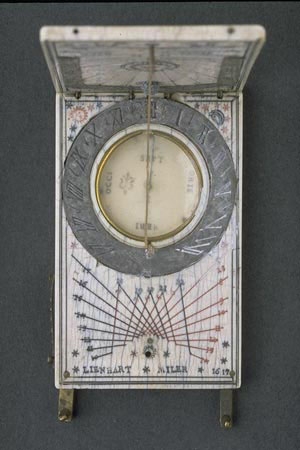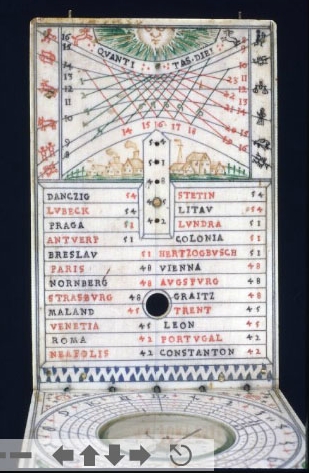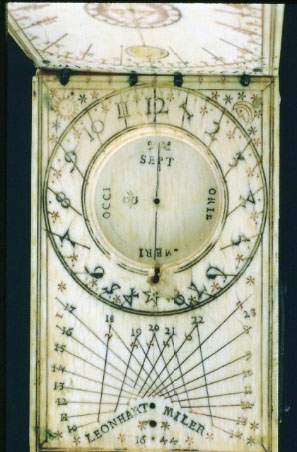Artists
Christoph
Maucher
(1642-1721)
German Ivory Carver
Do you think that you may own an ivory diptych by Leonhart Miller? We authenticate, appraise, research and issue certificates of authenticity (COA) and provide consultations for all ivory pieces by Leonhart Miller.
Ivory diptych dials became popular for telling time during the 16th and 17th centuries. These diptych dials, or sundials, were used as portable timepieces. The sun was used for telling time during the day, and the moon was used for telling time at night. Nuremberg, Germany was the leading center for sundial making during this time.

Ivory, inlaid metal. Inscription: [On base] Italian and Babylonian hours; [inside lid] length of days, 3.63" x 2.25" 1617

Open diptych, brass, ivory. closed: 1.4 x 7 x 10.8 cm (9/16 x 2 3/4 x 4 1/4 in.) 1636
Leonhart Miller was a famous sundial (kompassmacher) and scientific instrument maker who worked in Nuremberg. Not all sundials were signed, but many sundials made in Nuremberg bore punchmarks of the makers. The fleur-de-lys is the punchmark associated with both Lienhart and Leonhart Miller.
The above photograph shows a smaller standard sundial model which was made in large quantities over the 30 year span of Miller's workshop. inside of the base of this diptych is a compass bowl punchmarked with a fleur-de-lys. Below the compass is a horizontal dial with Italian and Babylonian hours, and the maker's inscription "LEINHART MILER 1617".
Diptych sundials consist of two plates hinged together by a string that serves as a gnomen. These plates open to form a right angle and have a viewing hole for a compass, a pin dial signifying the time of day, symbols of the Zodiac, as well as a dial for Italian and Babylonian hours. These beautiful timepieces told the time and would fit in your pocket. These intricate, portable sundials could be set for use in various latitudes, and equipped with devices helpful for merchants and travelers in Europe.

Bottom plate, brass, ivory closed: 1.4 x 7 x 10.8 cm (9/16 x 2 3/4 x 4 1/4 in.) 1636

Inside top plate, brass, ivory closed: 1.4 x 7 x 10.8 cm (9/16 x 2 3/4 x 4 1/4 in.) 1636

Open diptych, brass, ivory closed: 1.2 x 5.1 x 8.2 cm (1/2 x 2 x 3 1/4 in.) 1644

Inside top upright, ivory and brass closed: 1.2 x 5.1 x 8.2 cm (1/2 x 2 x 3 1/4 in.) 1644

Bottom plate, diptych, brass, ivory closed: 1.2 x 5.1 x 8.2 cm (1/2 x 2 x 3 1/4 in.) 1644
Some of these timepieces were used as instruments for measuring spring and accurately predicting when it would arrive. The day is equinox when the shadow of the sun tracks the horizontal line at the top of the upright. Some of these dials were also created to predict the weather.
Do you think you own an ivory diptych by Leonhart Miller? Contact us. We are the experts on Leonhart Miller.

Markings on Underside of Viola da Gamba Sundial
